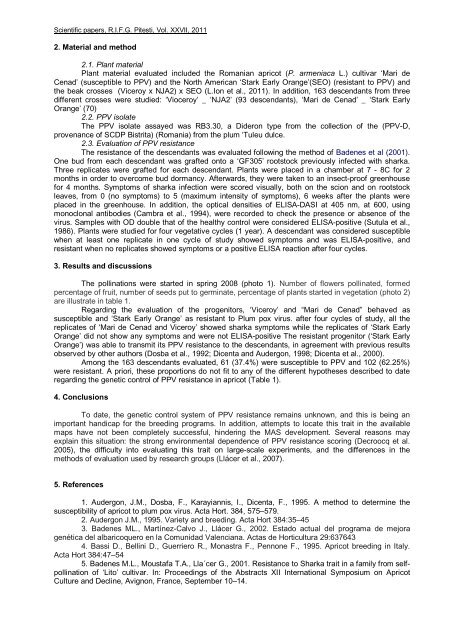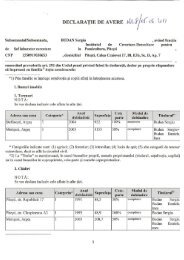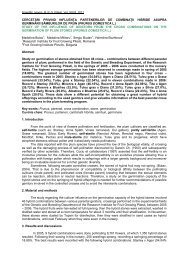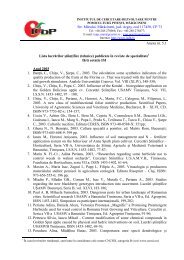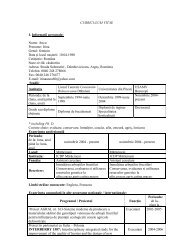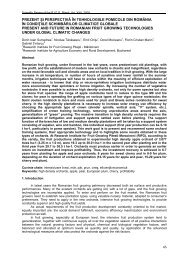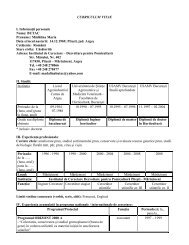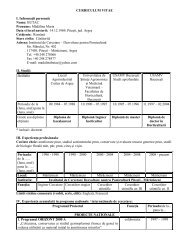05. Lucrare 2 Ligia Ion verificata - ICDP - Pitesti
05. Lucrare 2 Ligia Ion verificata - ICDP - Pitesti
05. Lucrare 2 Ligia Ion verificata - ICDP - Pitesti
Create successful ePaper yourself
Turn your PDF publications into a flip-book with our unique Google optimized e-Paper software.
Scientific papers, R.I.F.G. <strong>Pitesti</strong>, Vol. XXVII, 2011<br />
2. Material and method<br />
2.1. Plant material<br />
Plant material evaluated included the Romanian apricot (P. armeniaca L.) cultivar ‘Mari de<br />
Cenad’ (susceptible to PPV) and the North American ‘Stark Early Orange’(SEO) (resistant to PPV) and<br />
the beak crosses (Viceroy x NJA2) x SEO (L.<strong>Ion</strong> et al., 2011). In addition, 163 descendants from three<br />
different crosses were studied: ‘Vioceroy’ _ ‘NJA2’ (93 descendants), ‘Mari de Cenad’ _ ‘Stark Early<br />
Orange’ (70)<br />
2.2. PPV isolate<br />
The PPV isolate assayed was RB3.30, a Dideron type from the collection of the (PPV-D,<br />
provenance of SCDP Bistrita) (Romania) from the plum ‘Tuleu dulce.<br />
2.3. Evaluation of PPV resistance<br />
The resistance of the descendants was evaluated following the method of Badenes et al (2001).<br />
One bud from each descendant was grafted onto a ‘GF305’ rootstock previously infected with sharka.<br />
Three replicates were grafted for each descendant. Plants were placed in a chamber at 7 - 8C for 2<br />
months in order to overcome bud dormancy. Afterwards, they were taken to an insect-proof greenhouse<br />
for 4 months. Symptoms of sharka infection were scored visually, both on the scion and on rootstock<br />
leaves, from 0 (no symptoms) to 5 (maximum intensity of symptoms), 6 weeks after the plants were<br />
placed in the greenhouse. In addition, the optical densities of ELISA-DASI at 405 nm, at 600, using<br />
monoclonal antibodies (Cambra et al., 1994), were recorded to check the presence or absence of the<br />
virus. Samples with OD double that of the healthy control were considered ELISA-positive (Sutula et al.,<br />
1986). Plants were studied for four vegetative cycles (1 year). A descendant was considered susceptible<br />
when at least one replicate in one cycle of study showed symptoms and was ELISA-positive, and<br />
resistant when no replicates showed symptoms or a positive ELISA reaction after four cycles.<br />
3. Results and discussions<br />
The pollinations were started in spring 2008 (photo 1). Number of flowers pollinated, formed<br />
percentage of fruit, number of seeds put to germinate, percentage of plants started in vegetation (photo 2)<br />
are illustrate in table 1.<br />
Regarding the evaluation of the progenitors, ‘Viceroy’ and “Mari de Cenad” behaved as<br />
susceptible and ‘Stark Early Orange’ as resistant to Plum pox virus. after four cycles of study, all the<br />
replicates of ‘Mari de Cenad and Viceroy’ showed sharka symptoms while the replicates of ‘Stark Early<br />
Orange’ did not show any symptoms and were not ELISA-positive The resistant progenitor (‘Stark Early<br />
Orange’) was able to transmit its PPV resistance to the descendants, in agreement with previous results<br />
observed by other authors (Dosba et al., 1992; Dicenta and Audergon, 1998; Dicenta et al., 2000).<br />
Among the 163 descendants evaluated, 61 (37.4%) were susceptible to PPV and 102 (62.25%)<br />
were resistant. A priori, these proportions do not fit to any of the different hypotheses described to date<br />
regarding the genetic control of PPV resistance in apricot (Table 1).<br />
4. Conclusions<br />
To date, the genetic control system of PPV resistance remains unknown, and this is being an<br />
important handicap for the breeding programs. In addition, attempts to locate this trait in the available<br />
maps have not been completely successful, hindering the MAS development. Several reasons may<br />
explain this situation: the strong environmental dependence of PPV resistance scoring (Decroocq et al.<br />
2005), the difficulty into evaluating this trait on large-scale experiments, and the differences in the<br />
methods of evaluation used by research groups (Llácer et al., 2007).<br />
5. References<br />
1. Audergon, J.M., Dosba, F., Karayiannis, I., Dicenta, F., 1995. A method to determine the<br />
susceptibility of apricot to plum pox virus. Acta Hort. 384, 575–579.<br />
2. Audergon J.M., 1995. Variety and breeding. Acta Hort 384:35–45<br />
3. Badenes ML., Martínez-Calvo J., Llácer G., 2002. Estado actual del programa de mejora<br />
genética del albaricoquero en la Comunidad Valenciana. Actas de Horticultura 29:637643<br />
4. Bassi D., Bellini D., Guerriero R., Monastra F., Pennone F., 1995. Apricot breeding in Italy.<br />
Acta Hort 384:47–54<br />
5. Badenes M.L., Moustafa T.A., Lla´cer G., 2001. Resistance to Sharka trait in a family from selfpollination<br />
of ‘Lito’ cultivar. In: Proceedings of the Abstracts XII International Symposium on Apricot<br />
Culture and Decline, Avignon, France, September 10–14.


